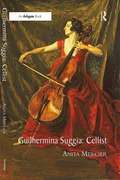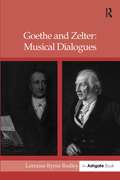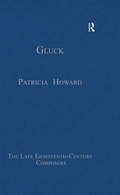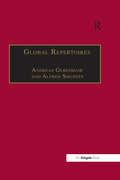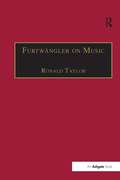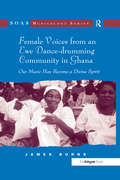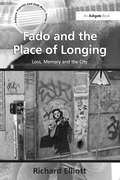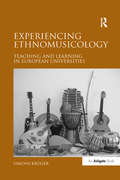- Table View
- List View
Gurudev's Drumming Legacy: Music, Theory and Nationalism in the Mrdang aur Tabla Vadanpaddhati of Gurudev Patwardhan (Soas Studies In Music Ser.)
by James KippenThe 1903 Mrdang aur Tabla Vadanpaddhati is a revelatory text that has never been translated or analysed. It is a manual for playing the two most important drums of North Indian (Hindustani) music, the pakhavaj (mrdang) and the tabla. Owing to its relative obscurity, it is a source that has never been discussed in the literature on Hindustani music. Its author, Gurudev Patwardhan, was Vice Principal of V.D. Paluskar's first music school in Lahore from its inception in 1901 to 1908. Professor James Kippen provides the first translation of this immensely important text and examines its startling implications for rhythmic and metric theory. It is the earliest work on Indian drumming to contain a notation sufficiently precise to allow definitive reconstruction. The compositions are of considerable musical interest, for they can be readily realized on the tabla or pakhavaj. Kippen sets the work and objectives of the original author in the context of a rich historical, social and political background. By also discussing radical differences in the second edition of 1938, published by Gurudev's nephew, the vocalist Vinayakrao Patwardhan, Kippen illuminates the process by which 'tabla theory' was being created in the early 20th century. Both Patwardhans were enthusiastic supporters of Paluskar's nationalist imperatives, and active participants in his drive to institutionalize music, codify and publish notations of it, and promote a modern, Hindu vision of India wherein its identity could once again be linked to a glorious golden age in distant antiquity.
Guilhermina Suggia: Cellist
by Anita MercierBorn in 1885 in Porto, Portugal, to a middle-class musical family, Guilhermina Suggia began playing cello at the age of five. A child prodigy, she was already a seasoned performer when she won a scholarship to study with Julius Klengel in Leipzig at the age of sixteen. Suggia lived in Paris with fellow cellist Pablo Casals for several years before World War I, in a professional and personal partnership that was as stormy as it was unconventional. When they separated Suggia moved to London, where she built a spectacularly successful solo career. Suggia's virtuosity and musicianship, along with the magnificent style and stage presence famously captured in Augustus John's portrait, made her one of the most sought-after concert artists of her day. In 1927 she married Dr Jos asimiro Carteado Mena and settled down to a comfortable life divided between Portugal and England. Throughout the 1930s, Suggia remained one of the most respected musicians in Europe. She partnered on stage with many famous instrumentalists and conductors and completed numerous BBC broadcasts. The war years kept her at home in Portugal, where she focused on teaching, but she returned to England directly after the war and resumed performing. When Suggia died in 1950, her will provided for the establishment of several scholarship funds for young cellists, including England's prestigious Suggia Gift. Mercier's study of Suggia's letters and other writings reveal an intelligent, warm and generous character; an artist who was enormously dedicated, knowledgeable and self-disciplined. Suggia was one of the first women to make a career of playing the cello at a time when prejudice against women playing this traditionally 'masculine' instrument was still strong. A role model for many other musicians, she was herself a fearless pioneer.
Guilhermina Suggia: Cellist
by Anita MercierBorn in 1885 in Porto, Portugal, to a middle-class musical family, Guilhermina Suggia began playing cello at the age of five. A child prodigy, she was already a seasoned performer when she won a scholarship to study with Julius Klengel in Leipzig at the age of sixteen. Suggia lived in Paris with fellow cellist Pablo Casals for several years before World War I, in a professional and personal partnership that was as stormy as it was unconventional. When they separated Suggia moved to London, where she built a spectacularly successful solo career. Suggia's virtuosity and musicianship, along with the magnificent style and stage presence famously captured in Augustus John's portrait, made her one of the most sought-after concert artists of her day. In 1927 she married Dr Jos asimiro Carteado Mena and settled down to a comfortable life divided between Portugal and England. Throughout the 1930s, Suggia remained one of the most respected musicians in Europe. She partnered on stage with many famous instrumentalists and conductors and completed numerous BBC broadcasts. The war years kept her at home in Portugal, where she focused on teaching, but she returned to England directly after the war and resumed performing. When Suggia died in 1950, her will provided for the establishment of several scholarship funds for young cellists, including England's prestigious Suggia Gift. Mercier's study of Suggia's letters and other writings reveal an intelligent, warm and generous character; an artist who was enormously dedicated, knowledgeable and self-disciplined. Suggia was one of the first women to make a career of playing the cello at a time when prejudice against women playing this traditionally 'masculine' instrument was still strong. A role model for many other musicians, she was herself a fearless pioneer.
Goethe and Zelter: Musical Dialogues
by LorraineByrne BodleyGoethe and Zelter spent a staggering 33 years corresponding or in the case of each artist, over two thirds of their lives. Zelter's position as director of the Sing-Akademie zu Berlin and Goethe's location in Weimar resulted in a wide-ranging correspondence. Goethe's letters offer a chronicle of his musical development, from the time of his journey to Italy to the final months of his life. Zelter's letters retrace his path as stonemason to Professor of Music in Berlin. The 891 letters that passed between these artists provide an important musical record of the music performed in public concerts in Berlin and in the private and semi-public soir of the Weimar court. Their letters are those of men actively engaged in the musical developments of their time. The legacy contains a wide spectrum of letters, casual and thoughtfully composed, spontaneous and written for publication, rich with the details of Goethe's and Zelter's musical lives. Through Zelter, Goethe gained access to the professional music world he craved and became acquainted with the prodigious talent of Felix Mendelssohn. A single letter from Zelter might bear a letter from Felix Mendelssohn to another recipient of the same family, reflecting a certain community in the Mendelssohn household where letters were not considered private but shared with others in a circle of friends or family. Goethe recognized the value of such correspondence: he complains when his friend is slow to send letters in return for those written to him by the poet, a complaint common in this written culture where letters provided news, introductions, literary and musical works. This famous correspondence contains a medley of many issues in literature, art, and science; but the main focus of this translation is the music dialogues of these artists.
Goethe and Zelter: Musical Dialogues
by LorraineByrne BodleyGoethe and Zelter spent a staggering 33 years corresponding or in the case of each artist, over two thirds of their lives. Zelter's position as director of the Sing-Akademie zu Berlin and Goethe's location in Weimar resulted in a wide-ranging correspondence. Goethe's letters offer a chronicle of his musical development, from the time of his journey to Italy to the final months of his life. Zelter's letters retrace his path as stonemason to Professor of Music in Berlin. The 891 letters that passed between these artists provide an important musical record of the music performed in public concerts in Berlin and in the private and semi-public soir of the Weimar court. Their letters are those of men actively engaged in the musical developments of their time. The legacy contains a wide spectrum of letters, casual and thoughtfully composed, spontaneous and written for publication, rich with the details of Goethe's and Zelter's musical lives. Through Zelter, Goethe gained access to the professional music world he craved and became acquainted with the prodigious talent of Felix Mendelssohn. A single letter from Zelter might bear a letter from Felix Mendelssohn to another recipient of the same family, reflecting a certain community in the Mendelssohn household where letters were not considered private but shared with others in a circle of friends or family. Goethe recognized the value of such correspondence: he complains when his friend is slow to send letters in return for those written to him by the poet, a complaint common in this written culture where letters provided news, introductions, literary and musical works. This famous correspondence contains a medley of many issues in literature, art, and science; but the main focus of this translation is the music dialogues of these artists.
Gluck: An Eighteenth-century Portrait In Letters And Documents (The\late Eighteenth-century Composers Ser.)
by Patricia HowardThis volume presents a collection of essays by leading Gluck scholars which highlight the best of recent and classic contributions to Gluck scholarship, many of which are now difficult to access. Tracing Gluck‘s life, career and legacy, the essays offer a variety of approaches to the major issues and controversies surrounding the composer and his works and range from the degree to which reform elements are apparent in his early operas to his contribution to changing perceptions of Hellenism. The introduction identifies the major topics investigated and highlights the innovatory nature of many of the approaches, particularly those which address perceptions of the composer in the nineteenth and twentieth centuries. This volume, which focuses on one of the most fascinating and influential composers of his era, provides an indispensable resource for academics, scholars and libraries.
Gluck
by Patricia HowardThis volume presents a collection of essays by leading Gluck scholars which highlight the best of recent and classic contributions to Gluck scholarship, many of which are now difficult to access. Tracing Gluck‘s life, career and legacy, the essays offer a variety of approaches to the major issues and controversies surrounding the composer and his works and range from the degree to which reform elements are apparent in his early operas to his contribution to changing perceptions of Hellenism. The introduction identifies the major topics investigated and highlights the innovatory nature of many of the approaches, particularly those which address perceptions of the composer in the nineteenth and twentieth centuries. This volume, which focuses on one of the most fascinating and influential composers of his era, provides an indispensable resource for academics, scholars and libraries.
Global Repertoires: Popular Music Within and Beyond the Transnational Music Industry
by Andreas GebesmairWith just four record companies controlling nearly 80 per cent of the world market in popular music, issues of globalization are evidently significant to our understanding of how and why popular music is made and distributed. As transnational industries seek to open up increasingly larger markets, the question of how local and regional music cultures can be sustained is a pressing one. To what extent does the global music market offer opportunities for the worldwide dissemination of local music within and beyond the major industry? The essays in this volume examine the structure and strategies of the transnational music industry, with its deployment of mass communication technologies including sound carriers, satellite broadcasting and the Internet. The book also explores local and individual experience of global music and this music's dissemination through migration and communities of interest, as well as the ideological and political use of different kinds of music. In contrast to recent arguments which posit an American imperialist dominance of popular music, the contributors to this volume find that the global repertoire of the major labels no longer represents the culture of a certain country but is fed by different sources. The essays here discuss how we can characterize this vast de-centered industry, and offer perspectives on the so-called 'international repertoire' that calls for a melodic structure, ballad forms, unaccented vocalisation and an image that has global recognition.
Global Repertoires: Popular Music Within and Beyond the Transnational Music Industry
by Andreas GebesmairWith just four record companies controlling nearly 80 per cent of the world market in popular music, issues of globalization are evidently significant to our understanding of how and why popular music is made and distributed. As transnational industries seek to open up increasingly larger markets, the question of how local and regional music cultures can be sustained is a pressing one. To what extent does the global music market offer opportunities for the worldwide dissemination of local music within and beyond the major industry? The essays in this volume examine the structure and strategies of the transnational music industry, with its deployment of mass communication technologies including sound carriers, satellite broadcasting and the Internet. The book also explores local and individual experience of global music and this music's dissemination through migration and communities of interest, as well as the ideological and political use of different kinds of music. In contrast to recent arguments which posit an American imperialist dominance of popular music, the contributors to this volume find that the global repertoire of the major labels no longer represents the culture of a certain country but is fed by different sources. The essays here discuss how we can characterize this vast de-centered industry, and offer perspectives on the so-called 'international repertoire' that calls for a melodic structure, ballad forms, unaccented vocalisation and an image that has global recognition.
Genesis and The Lamb Lies Down on Broadway
by Kevin Holm-HudsonIn 1974 the British progressive rock group Genesis released their double concept album The Lamb Lies Down on Broadway. The story was described by Genesis's then front-man Peter Gabriel as a 'moral fable' about Rael, a half-Puerto-Rican New York City street tough who is engulfed by a solid cloud into a series of strange adventures in a metaphysical realm. The album is a surreal allegory drawing its material from religious, literary and psychological themes. More than thirty years after its release, The Lamb Lies Down on Broadway still enthralls listeners, earning the distinction of being Genesis's most consistently selling back-catalogue release. Kevin Holm-Hudson analyses The Lamb within the context of Genesis's recorded output, within the progressive rock genre as a whole, and within the context of social and political changes of the mid 1970s. The Lamb marked a conscious shift in their story setting to America, and for the first time the songs were oriented to the present rather than the past or future. Significantly, while 1974 marked the peak of music industry growth and consolidation through corporate mergers, it was also the year in which America was confronted with its limits: through the first of the OPEC energy crises, the resignation of Richard Nixon, the withdrawal from Vietnam, and the effects of runaway inflation. Genesis's native Britain was also to feel the effects of the energy crisis, intensified by a period of economic slowdown that ultimately led to the rise of Thatcherism. The Lamb is set in New York City during this time of uncertainty. Within a few years the economic constraints would affect the industry as a whole and as a result progressive rock would suffer a precipitous drop in industry support. The Lamb Lies Down on Broadway thus makes a particularly rich subject for detailed study, providing compelling intersections between the musical, textual and socioeconomic aspects of an album.
Genesis and The Lamb Lies Down on Broadway
by Kevin Holm-HudsonIn 1974 the British progressive rock group Genesis released their double concept album The Lamb Lies Down on Broadway. The story was described by Genesis's then front-man Peter Gabriel as a 'moral fable' about Rael, a half-Puerto-Rican New York City street tough who is engulfed by a solid cloud into a series of strange adventures in a metaphysical realm. The album is a surreal allegory drawing its material from religious, literary and psychological themes. More than thirty years after its release, The Lamb Lies Down on Broadway still enthralls listeners, earning the distinction of being Genesis's most consistently selling back-catalogue release. Kevin Holm-Hudson analyses The Lamb within the context of Genesis's recorded output, within the progressive rock genre as a whole, and within the context of social and political changes of the mid 1970s. The Lamb marked a conscious shift in their story setting to America, and for the first time the songs were oriented to the present rather than the past or future. Significantly, while 1974 marked the peak of music industry growth and consolidation through corporate mergers, it was also the year in which America was confronted with its limits: through the first of the OPEC energy crises, the resignation of Richard Nixon, the withdrawal from Vietnam, and the effects of runaway inflation. Genesis's native Britain was also to feel the effects of the energy crisis, intensified by a period of economic slowdown that ultimately led to the rise of Thatcherism. The Lamb is set in New York City during this time of uncertainty. Within a few years the economic constraints would affect the industry as a whole and as a result progressive rock would suffer a precipitous drop in industry support. The Lamb Lies Down on Broadway thus makes a particularly rich subject for detailed study, providing compelling intersections between the musical, textual and socioeconomic aspects of an album.
Gabriel Fauré: The Songs and their Poets
by Graham JohnsonThe career of Gabriel Faur‘s a composer of songs for voice and piano traverses six decades (1862-1921); almost the whole history of French m die is contained within these parameters. In the 1860s Faur the lifelong prot of Camille Saint-Sa was a suavely precocious student; he was part of Pauline Viardot's circle in the 1870s and he nearly married her daughter. Pointed in the direction of symbolist poetry by Robert de Montesquiou in 1886, Faur as the favoured composer from the early 1890s of Winnarretta Singer, later Princesse de Polignac, and his songs were revered by Marcel Proust. In 1905 he became director of the Paris Conservatoire, and he composed his most profound music in old age. His existence, steadily productive and outwardly imperturbable, was undermined by self-doubt, an unhappy marriage and a tragic loss of hearing. In this detailed study Graham Johnson places the vocal music within twin contexts: Faur own life story, and the parallel lives of his many poets. We encounter such giants as Charles Baudelaire and Paul Verlaine, the patrician Leconte de Lisle, the forgotten Armand Silvestre and the Belgian symbolist Charles Van Lerberghe. The chronological range of the narrative encompasses Faur first poet, Victor Hugo, who railed against Napoleon III in the 1850s, and the last, Jean de La Ville de Mirmont, killed in action in the First World War. In this comprehensive and richly illustrated study each of Faur 109 songs receives a separate commentary. Additional chapters for the student singer and serious music lover discuss interpretation and performance in both aesthetical and practical terms. Richard Stokes provides parallel English translations of the original French texts. In the twenty-first century musical modernity is evaluated differently from the way it was assessed thirty years ago. Faur‘s no longer merely a 'Master of Charms' circumscribed by the belleque. His status as a great composer of timeless
Gabriel Fauré: The Songs and their Poets
by Graham JohnsonThe career of Gabriel Faur‘s a composer of songs for voice and piano traverses six decades (1862-1921); almost the whole history of French m die is contained within these parameters. In the 1860s Faur the lifelong prot of Camille Saint-Sa was a suavely precocious student; he was part of Pauline Viardot's circle in the 1870s and he nearly married her daughter. Pointed in the direction of symbolist poetry by Robert de Montesquiou in 1886, Faur as the favoured composer from the early 1890s of Winnarretta Singer, later Princesse de Polignac, and his songs were revered by Marcel Proust. In 1905 he became director of the Paris Conservatoire, and he composed his most profound music in old age. His existence, steadily productive and outwardly imperturbable, was undermined by self-doubt, an unhappy marriage and a tragic loss of hearing. In this detailed study Graham Johnson places the vocal music within twin contexts: Faur own life story, and the parallel lives of his many poets. We encounter such giants as Charles Baudelaire and Paul Verlaine, the patrician Leconte de Lisle, the forgotten Armand Silvestre and the Belgian symbolist Charles Van Lerberghe. The chronological range of the narrative encompasses Faur first poet, Victor Hugo, who railed against Napoleon III in the 1850s, and the last, Jean de La Ville de Mirmont, killed in action in the First World War. In this comprehensive and richly illustrated study each of Faur 109 songs receives a separate commentary. Additional chapters for the student singer and serious music lover discuss interpretation and performance in both aesthetical and practical terms. Richard Stokes provides parallel English translations of the original French texts. In the twenty-first century musical modernity is evaluated differently from the way it was assessed thirty years ago. Faur‘s no longer merely a 'Master of Charms' circumscribed by the belleque. His status as a great composer of timeless
Furtwänler on Music: Essays and Addresses by Wilhelm Furtwänler
by Ronald TaylorWilhelm Furtw ler left not only some of the greatest interpretations of operatic and symphonic music on record, but also expressed his views on musical issues of the moment in a number of outspoken essays and talks. His writings range from practical matters of performance and interpretation to aesthetic reflections on what he saw as the alarming direction in which music was developing in the wake of Schoenberg and the twelve-tone system of composition. Professor Ronald Taylor has here, for the first time, translated and annotated a selection of Furtw ler's writings covering the four decades from the First World War to the conductor's death in 1954, and prefaced them with an essay on Furtw ler's controversial career and complicated personality. The result is a collection of stimulating pieces with a claim on our attention, made all the greater for reflecting the musical and philosophical ideals of one of the great conductors of the twentieth century.
Furtwänler on Music: Essays and Addresses by Wilhelm Furtwänler
by Ronald TaylorWilhelm Furtw ler left not only some of the greatest interpretations of operatic and symphonic music on record, but also expressed his views on musical issues of the moment in a number of outspoken essays and talks. His writings range from practical matters of performance and interpretation to aesthetic reflections on what he saw as the alarming direction in which music was developing in the wake of Schoenberg and the twelve-tone system of composition. Professor Ronald Taylor has here, for the first time, translated and annotated a selection of Furtw ler's writings covering the four decades from the First World War to the conductor's death in 1954, and prefaced them with an essay on Furtw ler's controversial career and complicated personality. The result is a collection of stimulating pieces with a claim on our attention, made all the greater for reflecting the musical and philosophical ideals of one of the great conductors of the twentieth century.
From Soul to Hip Hop (The\library Of Essays On Popular Music Ser.)
by Tom PerchardThe essays contained in this volume address some of the most visible, durable and influential of African American musical styles as they developed from the mid-1960s into the 21st-century. Soul, funk, pop, R&B and hip hop practices are explored both singly and in their many convergences, and in writings that have often become regarded as landmarks in black musical scholarship. These works employ a wide range of methodologies, and taken together they show the themes and concerns of academic black musical study developing over three decades. While much of the writing here is focused on music and musicians in the United States, the book also documents important and emergent trends in the study of these styles as they have spread across the world. The volume maintains the original publication format and pagination of each essay, making for easy and accurate cross-reference and citation. Tom Perchards introduction gives a detailed overview of the book‘s contents, and of the field as a whole, situating the present essays in a longer and wider tradition of African American music studies. In bringing together and contextualising works that are always valuable but sometimes difficult to access, the volume forms an excellent introductory resource for university music students and researchers.
From Soul to Hip Hop
by Tom PerchardThe essays contained in this volume address some of the most visible, durable and influential of African American musical styles as they developed from the mid-1960s into the 21st-century. Soul, funk, pop, R&B and hip hop practices are explored both singly and in their many convergences, and in writings that have often become regarded as landmarks in black musical scholarship. These works employ a wide range of methodologies, and taken together they show the themes and concerns of academic black musical study developing over three decades. While much of the writing here is focused on music and musicians in the United States, the book also documents important and emergent trends in the study of these styles as they have spread across the world. The volume maintains the original publication format and pagination of each essay, making for easy and accurate cross-reference and citation. Tom Perchards introduction gives a detailed overview of the book‘s contents, and of the field as a whole, situating the present essays in a longer and wider tradition of African American music studies. In bringing together and contextualising works that are always valuable but sometimes difficult to access, the volume forms an excellent introductory resource for university music students and researchers.
Frederick the Great and his Musicians: The Viola da Gamba Music of the Berlin School
by Michael O'LoghlinAfter decades of stagnation during the reign of his father, the 'Barracks King', the performing arts began to flourish in Berlin under Frederick the Great. Even before his coronation in 1740, the crown prince commenced recruitment of a group of musician-composers who were to form the basis of a brilliant court ensemble. Several composers, including C.P.E. Bach and the Graun brothers, wrote music for the viola da gamba, an instrument which was already becoming obsolete elsewhere. They were encouraged in this endeavour by the presence in the orchestra from 1741 of Ludwig Christian Hesse, one of the last gamba virtuosi, who was described in 1766 as 'unquestionably the finest gambist in Europe'. This study shows how the unique situation in Berlin produced the last major corpus of music written for the viola da gamba, and how the more virtuosic works were probably the result of close collaboration between Hesse and the Berlin School composers. The reader is also introduced to the more approachable pieces which were written and arranged for amateur viol players, including the king's nephew and ultimate successor, Frederick William II. O'Loghlin argues that the aesthetic circumstances which prevailed in Berlin brought forth a specific style that is reflected not only in the music for viola da gamba. Characteristics of this Berlin style are identified with reference to a broad selection of original written sources, many of which are hardly accessible to English-speaking readers. There is also a discussion of the rather contradictory reception history of the Berlin School and some of its composers. The book concludes with a complete thematic catalogue of the Berlin gamba music, with a listing of original manuscript sources and modern publications. The book will appeal to professional and amateur viola da gamba players as well as to scholars of eighteenth-century German music.
Frederick the Great and his Musicians: The Viola da Gamba Music of the Berlin School
by Michael O'LoghlinAfter decades of stagnation during the reign of his father, the 'Barracks King', the performing arts began to flourish in Berlin under Frederick the Great. Even before his coronation in 1740, the crown prince commenced recruitment of a group of musician-composers who were to form the basis of a brilliant court ensemble. Several composers, including C.P.E. Bach and the Graun brothers, wrote music for the viola da gamba, an instrument which was already becoming obsolete elsewhere. They were encouraged in this endeavour by the presence in the orchestra from 1741 of Ludwig Christian Hesse, one of the last gamba virtuosi, who was described in 1766 as 'unquestionably the finest gambist in Europe'. This study shows how the unique situation in Berlin produced the last major corpus of music written for the viola da gamba, and how the more virtuosic works were probably the result of close collaboration between Hesse and the Berlin School composers. The reader is also introduced to the more approachable pieces which were written and arranged for amateur viol players, including the king's nephew and ultimate successor, Frederick William II. O'Loghlin argues that the aesthetic circumstances which prevailed in Berlin brought forth a specific style that is reflected not only in the music for viola da gamba. Characteristics of this Berlin style are identified with reference to a broad selection of original written sources, many of which are hardly accessible to English-speaking readers. There is also a discussion of the rather contradictory reception history of the Berlin School and some of its composers. The book concludes with a complete thematic catalogue of the Berlin gamba music, with a listing of original manuscript sources and modern publications. The book will appeal to professional and amateur viola da gamba players as well as to scholars of eighteenth-century German music.
Female Voices from an Ewe Dance-drumming Community in Ghana: Our Music Has Become a Divine Spirit
by James BurnsEwe dance-drumming has been extensively studied throughout the history of ethnomusicology, but up to now there has not been a single study that addresses Ewe female musicians. James Burns redresses this deficiency through a detailed ethnography of a group of female musicians from the Dzigbordi community dance-drumming club from the rural town of Dzodze, located in South-Eastern Ghana. Dzigbordi was specifically chosen because of the author's long association with the group members, and because it is part of a genre known as adekede, or female songs of redress, where women musicians critique gender relations in society. Burns uses audio and video interviews, recordings of rehearsals and performances and detailed collaborative analyses of song texts, dance routines and performance practice to address important methodological shifts in ethnomusicology that outline a more humanistic perspective of music cultures. This perspective encompasses the inter-linkages between history, social processes and individual creative artists. The voices of Dzigbordi women provide us not only with a more complete picture of Ewe music-making, they further allow us to better understand the relationship between culture, social life and individual creativity. The book will therefore appeal to those interested in African Studies, Gender Studies and Oral Literature, as well as ethnomusicology. Includes a DVD documentary.
Female Voices from an Ewe Dance-drumming Community in Ghana: Our Music Has Become a Divine Spirit
by James BurnsEwe dance-drumming has been extensively studied throughout the history of ethnomusicology, but up to now there has not been a single study that addresses Ewe female musicians. James Burns redresses this deficiency through a detailed ethnography of a group of female musicians from the Dzigbordi community dance-drumming club from the rural town of Dzodze, located in South-Eastern Ghana. Dzigbordi was specifically chosen because of the author's long association with the group members, and because it is part of a genre known as adekede, or female songs of redress, where women musicians critique gender relations in society. Burns uses audio and video interviews, recordings of rehearsals and performances and detailed collaborative analyses of song texts, dance routines and performance practice to address important methodological shifts in ethnomusicology that outline a more humanistic perspective of music cultures. This perspective encompasses the inter-linkages between history, social processes and individual creative artists. The voices of Dzigbordi women provide us not only with a more complete picture of Ewe music-making, they further allow us to better understand the relationship between culture, social life and individual creativity. The book will therefore appeal to those interested in African Studies, Gender Studies and Oral Literature, as well as ethnomusicology. Includes a DVD documentary.
Fado and the Place of Longing: Loss, Memory and the City
by Richard ElliottFado, often described as 'urban folk music', emerged from the streets of Lisbon in the mid-nineteenth century and went on to become Portugal's 'national' music during the twentieth. It is known for its strong emphasis on loss, memory and nostalgia within its song texts, which often refer to absent people and places. One of the main lyrical themes of fado is the city itself. Fado music has played a significant role in the interlacing of mythology, history, memory and regionalism in Portugal in the second half of the twentieth century. Richard Elliott considers the ways in which fado songs bear witness to the city of Lisbon, in relation to the construction and maintenance of the local. Elliott explores the ways in which fado acts as a cultural product reaffirming local identity via recourse to social memory and an imagined community, while also providing a distinctive cultural export for the dissemination of a 'remembered Portugal' on the global stage.
Fado and the Place of Longing: Loss, Memory and the City
by Richard ElliottFado, often described as 'urban folk music', emerged from the streets of Lisbon in the mid-nineteenth century and went on to become Portugal's 'national' music during the twentieth. It is known for its strong emphasis on loss, memory and nostalgia within its song texts, which often refer to absent people and places. One of the main lyrical themes of fado is the city itself. Fado music has played a significant role in the interlacing of mythology, history, memory and regionalism in Portugal in the second half of the twentieth century. Richard Elliott considers the ways in which fado songs bear witness to the city of Lisbon, in relation to the construction and maintenance of the local. Elliott explores the ways in which fado acts as a cultural product reaffirming local identity via recourse to social memory and an imagined community, while also providing a distinctive cultural export for the dissemination of a 'remembered Portugal' on the global stage.
Experiencing Ethnomusicology: Teaching and Learning in European Universities
by Simone Kr�gerSimone Kr�ger provides an innovative account of the transmission of ethnomusicology in European universities, and explores the ways in which students experience and make sense of their musical and extra-musical encounters. By asking questions as to what students learn about and through world musics (musically, personally, culturally), Kr�ger argues that musical transmission, as a reflector of social and cultural meaning, can impact on students' transformations in attitude and perspectives towards self and other. In doing so, the book advances current discourse on the politics of musical representation in university education as well as on ethnomusicology learning and teaching, and proposes a model for ethnomusicology pedagogy that promotes in students a globally, contemporary and democratically informed sense of all musics.
Experiencing Ethnomusicology: Teaching and Learning in European Universities
by Simone Kr�gerSimone Kr�ger provides an innovative account of the transmission of ethnomusicology in European universities, and explores the ways in which students experience and make sense of their musical and extra-musical encounters. By asking questions as to what students learn about and through world musics (musically, personally, culturally), Kr�ger argues that musical transmission, as a reflector of social and cultural meaning, can impact on students' transformations in attitude and perspectives towards self and other. In doing so, the book advances current discourse on the politics of musical representation in university education as well as on ethnomusicology learning and teaching, and proposes a model for ethnomusicology pedagogy that promotes in students a globally, contemporary and democratically informed sense of all musics.

